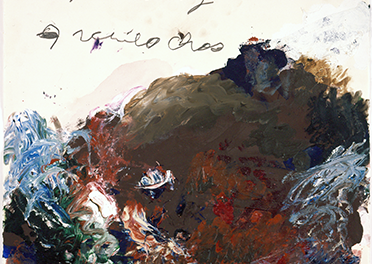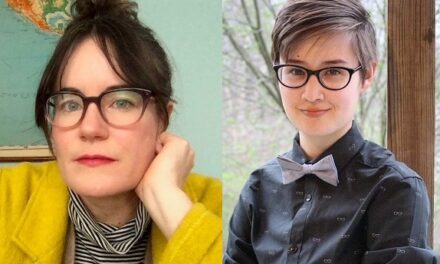
When we realized we’d be publishing both Joanna Pearson’s story “The Films of Roman Polanski” and Jillian Weiss’s essay “Invisible Man Asshole” (read excerpts here and here), we knew we wanted the two pieces in conversation together: though different genres, they both feature references to the devil and kids in care of the state/foster system. In addition to placing them next to each other in our Issue 16.1, we also decided this was the time to bring back the pas de deux blog series, a duet interview in which the authors ask questions of each other.
Today, we feature Weiss’s questions for Pearson; tomorrow, we’ll do the opposite:
Jillian Weiss: I’m very curious about the origin of this story. Specifically, I’m curious about what came first: the Devil Boy or the frightening pranks. The first sentence (and what a good first sentence!) presses these happenings together: “My boyfriend had no interest in scaring me until I began working with the Devil Boy.” Did they come to you thematically connected, or did one inspire the other over time?
Joanna Pearson: The origin of this story was actually the very first sentence, which wormed its way into my brain much like one of these bad pranks. I often start with a sentence and forge ahead on instinct, just like whoever it was that said writing is like driving at night and you can only see as far as your headlights shine. I had vague notions about a peculiar type of enmeshment that can happen in toxic relationships, especially when one person fears the alternate scenario—being alone, which somehow, despite all evidence to the contrary, seems worse.
JW: There is a lot of mystery in this story. To start, we seem to have an unreliable narrator, which shields the reader from certain aspects of reality. There is the way the Devil Boy makes Tawny and Beth Ann feel after they meet with him for the first time, headache-y and ill. There’s the question of what he did in his past foster placements and what he is doing to his current foster family. There’s the question of whether the boyfriend really is the one pranking Beth Ann, since they never speak of the pranks (as a reader, I kept changing my mind, which was fun!). Then, of course, there’s the suspenseful, open ending. Can you speak a little bit about your choice to insert these mysteries and the role they play in the tone and structure of the story?

JP: I agree with you that the narrator is unreliable, but I also feel like most narrators are, to varying degrees—and it’s a quality I love exploiting. Maybe reliable narrators exist, but only in this asymptotic way: you can get pretty close, but never all the way there. Even with a godlike omniscient third person, there’s still some perch or perspective from which the characters and actions are seen. There are just increasing degrees of subtlety or remove. But yeah, I’d say Beth Ann is rendered more unreliable by what she wishes for, and the tension created by that unreliability holds some inherent mystery.
It’s always my hope once I write a story that the mysteries within it can exist independently of my ex–post facto interpretations, but I would hazard that both the Devil Boy and the boyfriend are up to some badness. I think it’s unlikely that the Devil Boy would be able to execute all the pranks that Beth Ann experiences at home, though. But maybe more important than the question of who is doing what is the question of who is suggesting what and how it’s being suggested. I think there are some power plays happening. This mystery—the power of suggestion, or maybe the power of expectation—interests me. There’s a phenomenon in medicine called the “nocebo effect” which is sort of a negative corollary of the placebo effect. If you have the expectation that a sugar pill is going to give you a headache, you may well get one. I think people can have this sort of effect as well. And these placebo/nocebo effects do not describe something that’s fake or unreal or invalid, but rather describe real, measurable physiological effects that occur in response to expectation. This all probably makes it a little harder for us as readers, though, to draw clear bright lines regarding the events of this story.
JW: By the end of the story, the scene of Beth Ann and her boyfriend going to see Rosemary’s Baby feels extremely significant because the Devil Boy (Satan’s child, perhaps!) performs an act associated with a mother and child. I have begun to interpret the date scene as a piece of foreshadowing, particularly because the story mentions that the movie is rumored to be cursed and the recent happenings in Beth Ann’s life could be interpreted as the product of a curse. The scene also helped me to think of the story as a piece of horror, and I wonder if that was your intention. This leads me to two related questions:
A) Was the date scene designed to lead readers into the disturbing ending, to aid the turn into Polanski-esque horror?
B) Under what genre or genres of fiction would you place your story?
JP: Yes, the date scene was definitely a setup—a deliberately heavy-handed setup, but one that I allowed myself since this story is a bit of a riff on Rosemary’s Baby, which is itself rather (terrifically) heavy-handed. After I wrote my story, I happened to hear an interview with the New Yorker TV critic Emily Nussbaum in which she referred to Rosemary’s Baby as a “brilliant dark comedy and horror film about gaslighting and about rape culture” and “a feminist masterpiece created by a sex criminal.” Perfect descriptions. Nussbaum goes on to say that you don’t have to solve that contradiction to engage with it. Both Rosemary’s Baby and my story also have something to do with maternal longing—a longing that often gets knotty and complex when you actually examine it. There are real, unexpected dangers there, and I’m interested in that.
As for genre, I guess I would align this story with Henry James’s The Turn of the Screw or the short stories of Shirley Jackson or Carmen Maria Machado. Thrills, chills, and domesticity! I think it’s probably still “literary”—which, as best I can tell, means it’s concerned with the interiority of its characters. The horror element is a device. I’ve tried to write out-and-out genre fiction a couple times and failed. I’m better at speculating about the inner lives of people. But I love literary fiction that takes some of its cues from ghost stories or speculative fiction—one foot in, one foot out. At the end of the day, though, I’m not into true horror; I’m much more interested in eeriness and implication. The real world already contains more than its share of terrors.
Joanna Pearson is the author of the short-story collection Every Human Love (Acre Books, 2019). Her stories have recently appeared in Alaska Quarterly Review, Colorado Review, Ecotone, and Kenyon Review Online.
Jillian Weiss received her MFA from the University of North Carolina Wilmington. Her essays have been published in Missouri Review, Reed, Sycamore Review, and elsewhere. She lives in Portland, Oregon, with her husband and cat, and teaches creative writing for Duke University’s Talent Identification Program.
To read the story and essay in full, order Issue 16.1 in our online store—digital copies are only $5!











